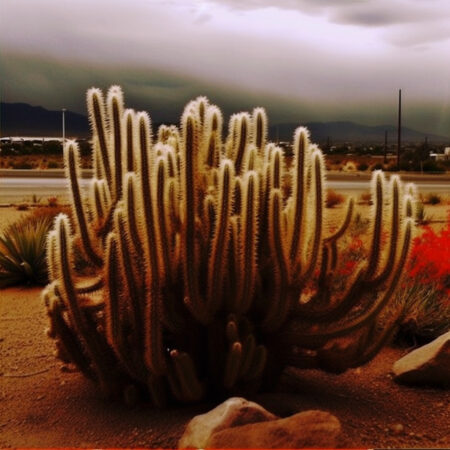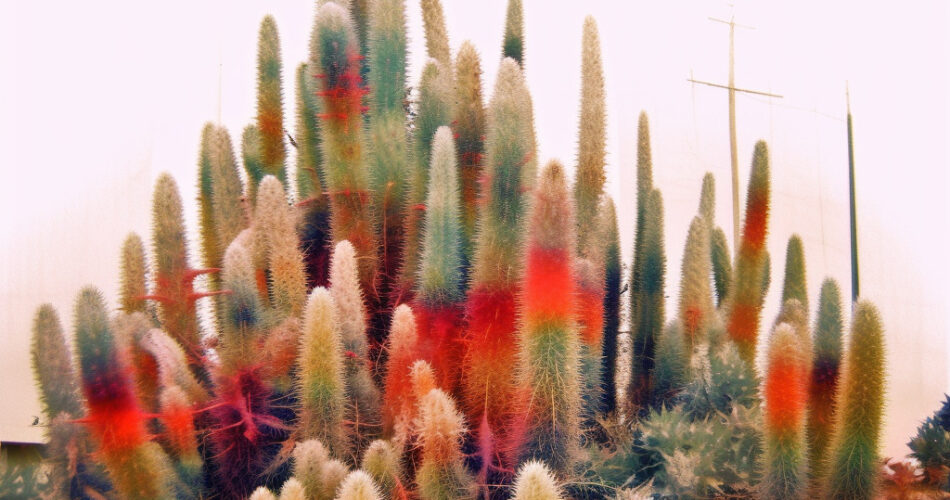Key Takeaways:
- It is a genus of cacti that are native to the high-altitude regions of South America.
- It has tall and slender growth habits with ribbed stems and dense spines.
- This cacti has various varieties, each with unique characteristics.
- It has cultural significance and symbolic meanings.
- Provide this cactus with bright, indirect light, mild to warm temperatures, and low humidity levels.
- Use well-draining soil and a pot with drainage holes for it.
- Water it sparingly and avoid over-fertilizing.
- Watch out for pests like mealybugs and prevent root rot and fungal diseases.
- Pruning and repotting are occasionally necessary for this cacti.
- Manage it during its dormancy period.
- Display this cactus indoors or outdoors in creative ways.
- Use unique containers and terrariums to showcase Cleistocactus.
- Create cactus arrangements and landscapes for DIY projects.
1. Understanding the Fascinating World of Cleistocactus
Cleistocactus, also known as Monkey Tail Cactus, is a genus of cacti that belongs to the Cactaceae family. These fascinating plants are native to the high-altitude regions of South America, particularly in the Andes Mountains. Cleistocactus derives its name from the Greek words “kleistos” meaning closed, and “kaktos” meaning thistle, referring to the closed flower buds that resemble thistles.
A Brief Introduction to Cleistocactus
Cleistocactus is a group of columnar cacti known for their tall and slender growth habit. These cacti can grow up to several feet in height, with some species reaching heights of over ten feet. They have ribbed stems characterized by spines that grow in clusters along the ribs. It is often recognized by its unique cylindrical shape and its ability to produce beautiful flowers.
The Unique Features and Varieties
There are several fascinating features that set Cleistocactus apart from other cacti species. One notable feature is the presence of dense spines that form a protective layer on the stems. These spines help the plant to withstand harsh weather conditions and protect it from foraging animals.
Cleistocactus also has a diverse range of varieties, each with its own unique characteristics. Some popular varieties include Cleistocactus strausii, Cleistocactus winteri, and Cleistocactus samaipatanus. Each variety offers a distinct growth pattern, spination, and flower color, adding to the overall appeal of these plants.
The Traditional and Symbolic Meanings Associated with Cleistocactus
`it has deep-rooted cultural significance in the regions where it is native. In Andean cultures, these cacti symbolize resilience, adaptability, and endurance. They are considered symbols of strength and are believed to bring good luck and protection to households.
The vibrant flowers that this cactus produces also hold symbolic meanings. The red flowers, for example, are often associated with love and passion, while yellow flowers symbolize happiness and joy. This cacti is often used in traditional celebrations and rituals to bring positive energy and good fortune.
2. Essential Tips for Growing Healthy Cleistocactus
Growing Cleistocactus can be an enjoyable experience, especially when you understand and provide the essential care requirements. Here are some expert tips to help you grow healthy and vibrant Cleistocactus plants.
The Perfect Environment: Light, Temperature, and Humidity
One of the key factors in successfully growing Cleistocactus is providing them with the right environmental conditions. These cacti thrive in bright, indirect light, so it’s essential to place them near a window where they can receive ample sunlight.
When it comes to temperature, Cleistocactus prefer mild to warm conditions. They can tolerate temperatures ranging from 65 to 80 degrees Fahrenheit (18 to 27 degrees Celsius) during the growing season. However, it’s crucial to protect them from frost and extreme cold temperatures.
Cleistocactus also prefer low humidity levels, similar to their natural habitat. It’s important to provide good air circulation and avoid excessively humid environments, as this can lead to fungal diseases and rot.
Choosing the Right Soil and Pot
The choice of soil and pot can greatly impact the health and growth of Cleistocactus. These cacti require well-draining soil to prevent moisture retention, which can lead to root rot. A mixture of cactus potting soil, perlite, and coarse sand is an ideal option to provide good drainage.
When selecting a pot, opt for a container with drainage holes to allow excess water to escape. The pot should also be slightly larger than the plant’s root system, providing enough room for growth while preventing excessive moisture accumulation.
Watering and Fertilizing Cleistocactus: Dos and Don’ts
Proper watering is crucial for the health and survival of Cleistocactus. These cacti have a natural ability to store water in their stems, allowing them to tolerate periods of drought. It’s important to follow a minimal watering approach, allowing the soil to dry out completely between waterings.
During the growing season, which typically occurs in spring and summer, water Cleistocactus every two to three weeks. Reduce watering in the winter months, as the plants enter a dormant phase.
When it comes to fertilizing Cleistocactus, a balanced cactus fertilizer can be applied during the growing season to provide essential nutrients. However, it’s important to follow the instructions on the fertilizer package and avoid over-fertilizing, as this can lead to root burn and other issues.

3. Common Challenges and How to Care for Cleistocactus
While Cleistocactus is generally a resilient plant, it can still face certain challenges. Understanding and addressing these challenges promptly is essential for the overall health and longevity of your Cleistocactus.
Pest and Disease Control: Identifying and Treating Common Issues
One common pest that can affect Cleistocactus is the mealybug. These small insects feed on the plant’s sap, causing wilting and stunted growth. Regularly inspect your Cleistocactus for signs of mealybugs, such as white cottony residue on the stems or leaves. If detected, treat the infestation with organic insecticidal soap or neem oil.
Root rot and fungal diseases can also be a concern for Cleistocactus, especially when overwatering occurs or the plant is exposed to excessive moisture. To prevent such issues, ensure proper drainage, avoid water stagnation, and provide good air circulation.
Pruning and Repotting: When and How to Do It
Pruning is generally not required for Cleistocactus, as they naturally maintain their shape and size. However, if you notice any dead or damaged parts, you can carefully remove them using a clean, sharp knife or scissors.
Repotting is usually necessary when the current pot becomes too small or when you want to refresh the soil mix. It’s best to repot Cleistocactus during the spring or early summer when they are actively growing. When repotting, gently remove the plant from its current pot, trim any roots that appear damaged or overgrown, and place it in a new pot with fresh well-draining soil.
Managing Cleistocactus During Dormancy Periods
Cleistocactus naturally enters a dormant phase during the winter months when their growth slows down. During this period, it’s important to reduce watering and avoid fertilizing the plants. Keep the Cleistocactus in a cool location away from drafts, as sudden temperature changes can be detrimental to their health.
4. Creative and Stylish Ways to Display Cleistocactus
Cleistocactus can not only thrive as individual plants but also make stunning decorative elements in various settings. Here are some creative and stylish ways to display your Cleistocactus:
Indoor and Outdoor Decor
Bring a touch of nature into your home by incorporating Cleistocactus into your interior design. These tall and slender cacti can be placed in living rooms, hallways, or even as a focal point in an empty corner. Cleistocactus can also thrive in outdoor gardens, adding vertical interest and unique textures to your landscape.
Unique Containers and Terrarium Ideas
Get creative with the containers you choose for your Cleistocactus. Consider using aesthetically appealing pots or even repurposed items such as vintage teacups, glass jars, or hanging planters. Cleistocactus can also be featured in terrariums, creating a mini desert ecosystem that’s both visually appealing and easy to maintain.
DIY Projects: Creating Cleistocactus Arrangements and Landscapes
Unleash your creativity by designing Cleistocactus arrangements and landscapes. Combine different varieties of this catus with other succulents, rocks, and ornamental elements to create visually striking displays. Take inspiration from desert landscapes or create your own miniature desert garden in a large container.
By following these expert tips and understanding the unique characteristics of Cleistocactus, you can successfully grow and care for these fascinating cacti. Enjoy the journey of cultivating and displaying it while appreciating their beauty and symbolic meanings.
FAQ
Question: What are some tips for growing healthy Cleistocactus?
Growing healthy cactus involves providing the right environmental conditions such as bright, indirect light, mild to warm temperatures, and low humidity levels. It’s important to use well-draining soil and a pot with drainage holes. Water sparingly, allow the soil to dry out completely between waterings, and avoid over-fertilizing. Watch out for pests like mealybugs and prevent root rot and fungal diseases. Pruning and repotting may be necessary, and manage this cacti during its dormancy period.
Question: What are some common challenges in caring for Cleistocactus?
Common challenges in caring for this cactus include pest and disease control. Mealybugs can be a problem, and they can be treated with organic insecticidal soap or neem oil. Root rot and fungal diseases can occur if there is excessive moisture or overwatering. Pruning may be necessary for dead or damaged parts, and repotting may be required when the current pot becomes too small or when refreshing the soil mix.
Question: How can I display Cleistocactus creatively and stylishly?
It can be displayed indoors and outdoors in various creative ways. They make stunning decorative elements in home design and can be placed in living rooms, hallways, or as focal points. This cactus can also thrive in outdoor gardens, adding vertical interest and unique textures to landscapes. Get creative with unique containers such as vintage teacups, glass jars, or hanging planters. It can also be featured in terrariums, creating mini desert ecosystems. DIY projects like creating Cleistocactus arrangements and landscapes allow for visually striking displays.
Question: What is the cultural significance and symbolic meaning of Cleistocactus?
It carries cultural significance and symbolic meanings. In Andean cultures, they symbolize resilience, adaptability, and endurance. This cactus is believed to bring good luck and protection to households. The vibrant flowers hold symbolic meanings, with red flowers representing love and passion, and yellow flowers symbolizing happiness and joy. Cleistocactus is used in traditional celebrations and rituals to bring positive energy and good fortune.




Comments